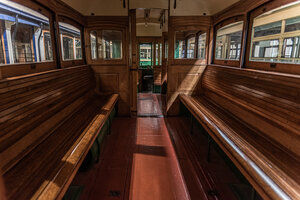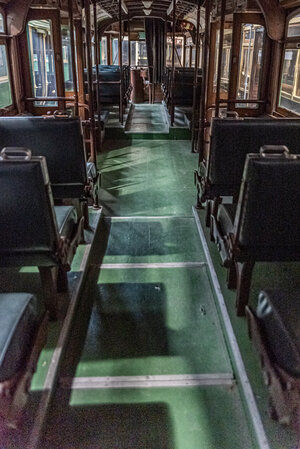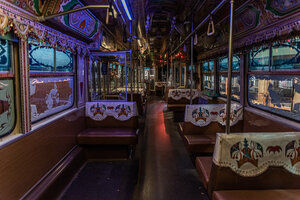
Melbourne Trams
Travelling between past and present
This work is about exploring the world of Melbourne’s trams, their influence on Melbourne’s culture, people and history as elements that form our society, the importance of heritage and architectural buildings.
The research is first based on archaeologist Gary Vines: “Cultural heritage legislation protecting historical heritage places applies in Victoria (…). These places are an important part of our heritage as they can provide us with important information about past lifestyles and cultural change”[1]. One of my visual inspirations is Yanni Florence, with his last exhibition “Tram Windows”, he uses the windows of the tram to frame portrait of people “mostly passively waiting for their journey’s end, looking out, watching the world go by”[2], Florence said.
Roberta made this work to explore how people, architecture and Heritage are all parts of our identity. By creating an installation that gives a full sensorial experience to the viewer, creating a sculpture and adding the sound of the tram running, she wants to challenge herself in exhibit work in a non-classic way, not the usual pictures on the wall, but something different, almost interactive. She is inspired by Dr Daniel Palmer, in his symposium he writes: “inter-fabrications of photography, sculpture, and historical narratives clearly have the capacity to introduce complex temporal layers to our experience of a place”[3]
The sound of the tram running is being recorded on an iPhone while she was riding tram #11 from Thornbury to RMIT City Campus. She is also inspired by Robert Morris “Box with the sound of its own making”. Xennex in their Wikiart article describes it: “consists of an unadorned wooden cube, accompanied by a recording of the sounds produced during its construction”[4].

Finally the sculpture she made, resembles a tram model, made with a wooden structure, papier maché and painted with acrylic colors, inspired by Vincent Fecteau, who affirms that “sculpture is about moving all around something because you have to see it constantly, it is about an interaction of a person and an object”[5].


Roberta is informed and getting other inspirations also from the landscape and interior photography of Eugene Atget who saw Paris’s medieval neighbourhoods getting destroyed and started to document them. Atget informs her photographs of old tram engines and Victorian Heritage buildings because she also wants to document the architecture of Melbourne before its disappearance to modernization. Atget’s straightforward yet wistful style also served as an inspiration for her, the simple and frontal photography of buildings related to the tram’s history helps the viewer to not get distracted by other details and focus on just the subject of the photograph.
Another photographer of inspiration is Rebecca Bathory, who captures abandoned places because she loves “finding beauty in darkness, poetry and meaning in the forgotten and surreal, imaginary worlds amongst decay” [6]. Roberta is deeply fascinated by forgotten historical locations and she is impressed by Bathory’s composition skills, light and use of medium format camera. In Roberta’s photographs inside the old trams at the Melbourne Tram Museum, she tried to recreate the same lighting and desaturation to give a sense of abandonment. These old trams are beautifully cared for by volunteers at the Melbourne Tram Museum.
















Strongly inspired by Yanni Florence, himself influenced by Robert Frank’s “A foreigner’s road trip”, Roberta took photographed of unaware people inside a tram and cropped it as a portrait. They represent our culture, they are bystanders of history, projecting in front of their own eyes. The tram is just a way to travel but also defines the site of her work, it carries the sound of the tram itself, it is projecting the journey of details and places, the stops and the movements, beginnings and ends, heritage places and ghosts, combining multisensorial experiences and offering new opportunities for viewers to actively participate in the artwork.


























